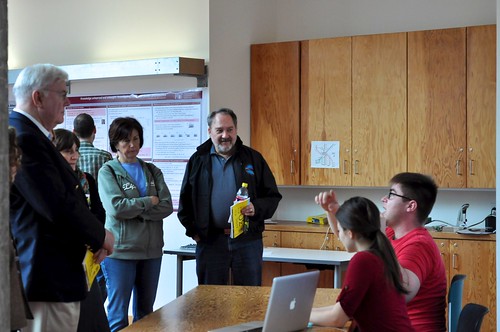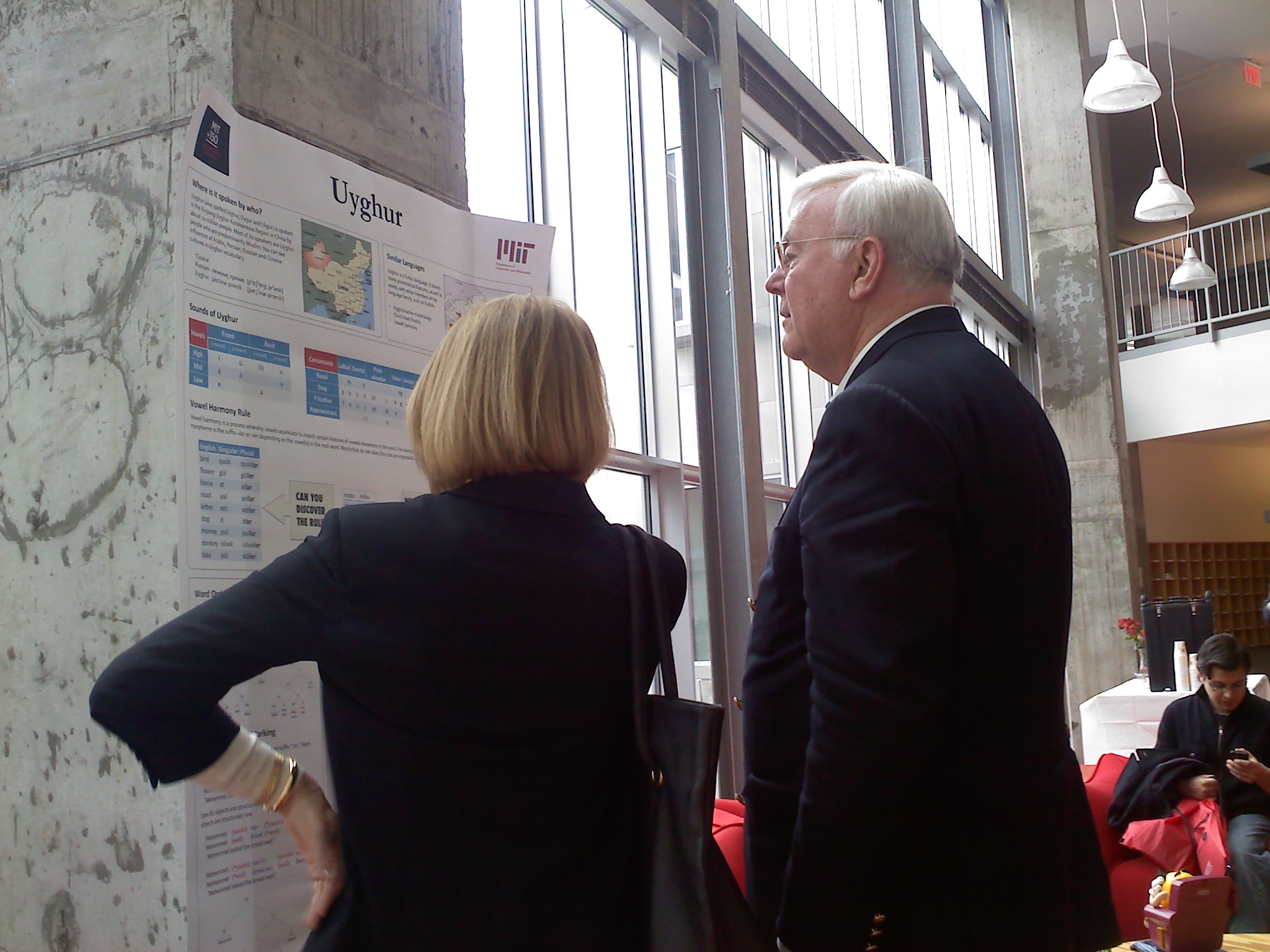Time: Monday, May 2, 11:30am
Location: 32-D461
Kirill Shklovsky will be discussing Elena Anagnostopoulou’s “The Syntax of Ditransitives.”
The Weekly Newsletter of MIT Linguistics
Time: Monday, May 2, 11:30am
Location: 32-D461
Kirill Shklovsky will be discussing Elena Anagnostopoulou’s “The Syntax of Ditransitives.”
Speaker: Nina Topintzi
Title: The (morpho)phonology of the Greek glide and the palatals
Time: Tuesday 5/3, 5-6pm, 32-D831
The glide [j] has been notorious in the Greek literature as a segment whose nature alternates in complex ways between that of an allophone of /i/ as well as of a phoneme distinct from it. Past accounts have managed to capture a fairly limited set of the data, most frequently by making recourse to historical or sociolinguistic factors. The aim of this talk is to improve on this situation by analysing a wider set of facts and by promoting the role pure grammatical factors play. The first part of the talk offers a proposal for the glide which attempts to elucidate its various facets uniformly with the added bonus that it can extend to an analysis of palatals (also problematic in the literature). In the second part, I present a first take on the behaviour of the glide in various morpho-phonological environments. It will become obvious that while the preceding analysis works satisfactorily for a large part of the data, a lot remains to be understood.
Upcoming talks:
May 10: RUMMIT practice talks
You can view the current, up-to-date version of the schedule here (click ‘agenda’ to see the schedule as a list), or subscribe via iCal here.
Speaker: Shin Ishihara
Title: Japanese Focus Prosody Revisited: Freeing Focus from Prosodic Phrasing
Time: Thurs 5/5, 11am-12pm, 32-D461 ***NOTE SPECIAL DATE, TIME, AND LOCATION
This talk revisits empirical and theoretical problems of focus prosody in Japanese, and proposes a new analysis. Contrary to the widely accepted assumption that focus directly or indirectly modifies prosodic phrasing, various studies have shown that prosodic boundaries remain unchanged when a focus is added to a sentence. It is proposed that phonetic effects of focus (F0-rise on the focused word, and reduction in the post-focal areas) result from manipulations of metrical prominences (addition of focal prominence on the focused word and deletion of head prominences in the post-focal area) that have no effect on prosodic boundaries. In order to allow prominence manipulation while keeping prosodic phrasing intact, two modifications are made to one of the widely accepted Optimality-Theoretic analyses of focus prosody. First, the syntax-prosody alignment constraint will be ranked higher, which allows it to dictate the location of prosodic boundaries. Second, metrical culminativity (one metrical prominence per prosodic constituent) is treated as a violable constraint, and it is proposed that this constraint is low-ranked in Japanese. As a result, Japanese allows multi-headed phrases (when focus adds a prominence), as well as headless prosodic phrases (when focus deletes post-focal prominences).
Speaker: Marios Mavrogiorgos
Title: V-movement to a V-related head and enclisis: a view from finiteness sensitive and Tobler-Mussafia languages
Location: 32-D461
Time: Thursday, May 5, 12:30-1:45pm
The proclisis-enclisis alternation is found in most languages having clitic pronouns. One basic observation made by many researchers is that clitic languages can be distinguished into two basic types depending on whether finiteness plays a role in the alternation or not. In the literature there have been different analyses of enclisis. For example, we can find both syntactic and PF approaches either for finiteness sensitive languages or for non finiteness sensitive languages, or for both. However, most of the existent analyses face problems, and moreover it is not clear what underlies the basic distinction between the two language types. In this talk I will propose a unified analysis for both finiteness sensitive and non finiteness sensitive languages. My main claim will be that enclisis arises in both language types only when V moves across the cliticization site to a V-related head (in the sense of Chomksy 1993, Rizzi 1997). The finiteness factor will be reduced to impoverished person agreement that correlates with V-related features in a head higher than the cliticization site, which trigger V movement. The difference between the two language types wrt. to their sensitivity in finiteness will be accounted for as a difference in the spelled-out morphology of different types of V-related features in each language type: agr/mood features in finiteness sensitive languages/structures vs. affective features in non finiteness sensitive languages. Checking of V-related features in both language types will be argued to be subject to an economy principle which requires that the feature is checked by an overt element which is either a head or a spec. In this respect, two types of features will be distinguished: V-related features, which carry a PF-requirement and give rise to enclisis, and non V-related features, which do not carry a PF requirement and which correlate with proclisis. According to this distinction, enclisis is seen as morphological (re)ordering of V-related heads. A theoretical implementation of this basic intuition will be provided, and further typological and other issues will be discussed.
WHO: Alan Bale
WHAT: Singular, Plural, and Obligatory Competition
WHEN: May 6, 2:00PM-3:15PM
WHERE: 32-D831
ABSTRACT:
Several theories have proposed that number marking, in particular singular and plural marking, compete with one another and that this competition influences how nouns are interpreted. Evidence in support of this proposal usually comes from languages like English where singular nouns have a strict singular interpretation. In such languages, it is hypothesized that plural nouns are literally unspecified for number but receive a strict plural interpretation through (obligatory) competition with the singular (see Krifka, 1989; Spector, 2007; and Sauerland et al., 2005).
This talk investigates whether singular and plural marking in Turkish and Western Armenian compete with one another. Unlike English, the so-called singular nouns in these languages do not have a strict singular interpretation, but rather can be used to quantify over both groups and individuals. In contrast, the plural nouns have a strict plural interpretation. As will be shown, there is evidence of competition in these languages but such competition critically relies on a comparison of syntactic complexity. Such a conclusion has cross-linguistic consequences for all types of competition, especially with respect to number marking.
The department opened its doors to visitors last Saturday as part of the MIT-wide open house Under the Dome, and received a steady stream of visitors curious about our contribution, a series of activities under the theme “Language and the Human Mind”.
Visitors learned about a number of interesting languages, among them the Mayan languages of Central America, Uyghur and the Wampanoag language of the native inhabitants of Massachusetts. They viewed posters explaining recent research projects our graduate students and UROPs have undertaken, stepped into the Experimental Syntax & Semantics Lab to participate in psycholinguistic experiments designed to reveal how language interfaces with the conceptual-intentional systems of the mind, then hunkered down to solve linguistics puzzles about Mayan, with chocolate their reward for correct answers.
A selection of photos from the event (more here):



Thank you to all who participated in the open house and made it a success! Thanks also to Adam Albright, Micha Breakstone, Mitcho Erlewine, Jeremy Hartman and Kirill Shklovsky for reports and photographs.
MIT undergraduate linguistics (and math) major John Berman (class of 2013) will be heading to Chiapas, Mexico this summer with members of the Harvard Language Processing Lab (including recent graduate Jessica Coon), where he will help run an experiment on processing of relative clauses in the Tumbalá dialect of Chol. The experiment will investigate processing speeds of ergative and absolutive argument extraction in the language. After the rest of the lab group heads back to Cambridge, John will stay on for a month in a Chol-speaking village to continue his own work on the language.
Speaker: Shin Ishihara (J.W. Goethe-Universität, Frankfurt am Main)
Time: Friday, May 6, 2011, 3:30pm-5pm
Location: 32-141 (PLEASE NOTE THE ROOM)
Title: On the Clause-Mate Condition in Japanese: Implicit Prosody and
Argument Structure Parsing
Abstract:
In some syntactic constructions in Japanese, more than one constituent can move together to a certain syntactic position. One example is the cleft construction: Japanese clefts allow multiple constituents to appear in the focus position (`It is x, y that … t(x) … t(y)…’). It has often been claimed that such constituents must originate from the same clause, i.e., they must be clause-mates (= the Clause-Mate Condition, the CMC). This condition has often been analyzed as a syntactic constraint that strictly bans any syntactic derivation violating it. There are, however, cases where the CMC can be obviated. For example, if the cleft sentence with multiple foci is a wh-question (`Who(x), what(y) is it that … t(x) … t(y) …?’), the sentence acceptability improves compared to its declarative counterpart. So far, no account has been proposed that can explain both the CMC and the CMC obviation cases.
In this talk, I claim that the Clause-Mate Condition in Japanese is not a syntactic constraint, and propose that the CMC effect comes from the influence of `implicit prosody’ on sentence parsing. Adopting the Implicit Prosody Hypothesis (Fodor 1998, 2002), I will propose a parsing principle which imposes a certain bias on the argument structure comprehension according to the prosodic phrasing in the implicit prosody. This analysis can explain both the CMC effect in clefts with multiple focus constituents and its obviation effect under certain conditions (including interrogatives) in a parallel fashion.
The analysis also makes further predictions on potential parsing difficulties in other constructions such as long-distance scrambling. It will be suggested that some of the mysterious restrictions found in long-distance scrambling in Japanese (e.g., ban on long-distance scrambling to a sentence-medial position, ban on scrambling of nominative subjects) are related to the parsing difficulty caused by the implicit prosody.